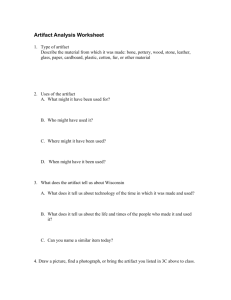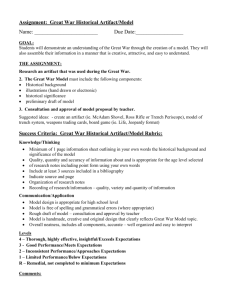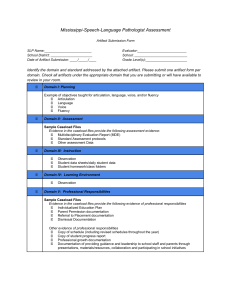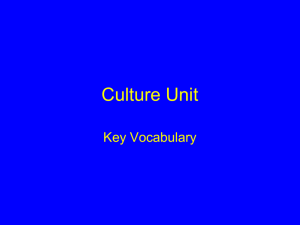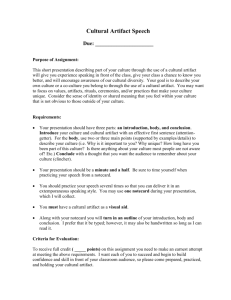Case Study - kckpsportfolio
advertisement
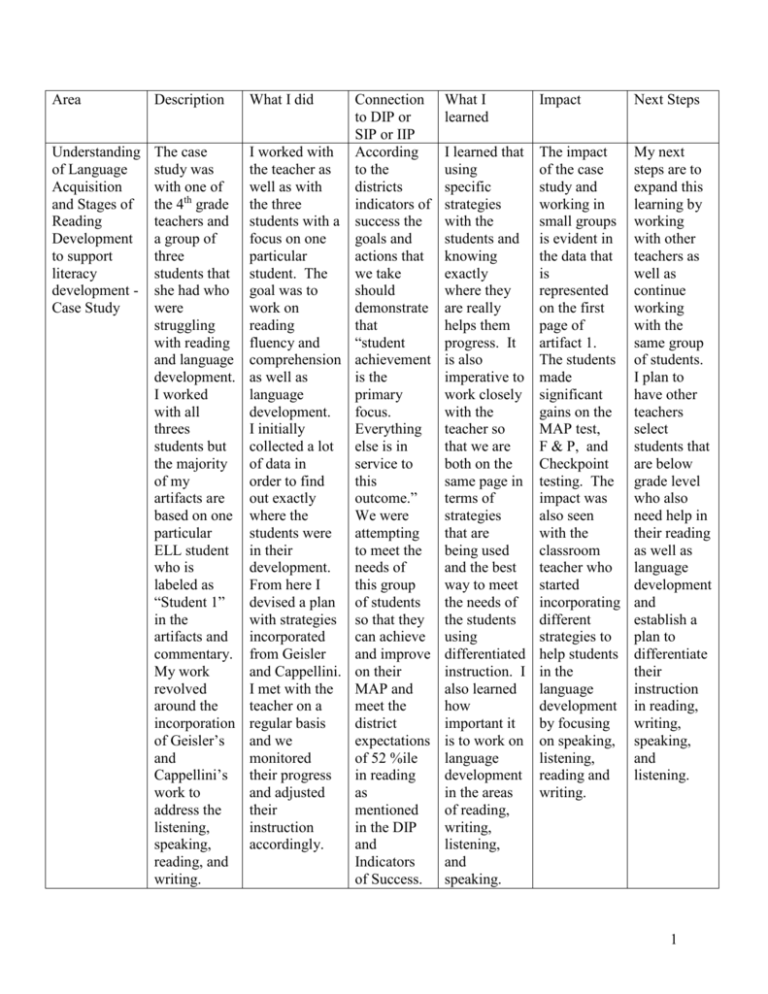
Area Description What I did Connection to DIP or SIP or IIP Understanding The case I worked with According of Language study was the teacher as to the Acquisition with one of well as with districts and Stages of the 4th grade the three indicators of Reading teachers and students with a success the Development a group of focus on one goals and to support three particular actions that literacy students that student. The we take development - she had who goal was to should Case Study were work on demonstrate struggling reading that with reading fluency and “student and language comprehension achievement development. as well as is the I worked language primary with all development. focus. threes I initially Everything students but collected a lot else is in the majority of data in service to of my order to find this artifacts are out exactly outcome.” based on one where the We were particular students were attempting ELL student in their to meet the who is development. needs of labeled as From here I this group “Student 1” devised a plan of students in the with strategies so that they artifacts and incorporated can achieve commentary. from Geisler and improve My work and Cappellini. on their revolved I met with the MAP and around the teacher on a meet the incorporation regular basis district of Geisler’s and we expectations and monitored of 52 %ile Cappellini’s their progress in reading work to and adjusted as address the their mentioned listening, instruction in the DIP speaking, accordingly. and reading, and Indicators writing. of Success. What I learned Impact Next Steps I learned that using specific strategies with the students and knowing exactly where they are really helps them progress. It is also imperative to work closely with the teacher so that we are both on the same page in terms of strategies that are being used and the best way to meet the needs of the students using differentiated instruction. I also learned how important it is to work on language development in the areas of reading, writing, listening, and speaking. The impact of the case study and working in small groups is evident in the data that is represented on the first page of artifact 1. The students made significant gains on the MAP test, F & P, and Checkpoint testing. The impact was also seen with the classroom teacher who started incorporating different strategies to help students in the language development by focusing on speaking, listening, reading and writing. My next steps are to expand this learning by working with other teachers as well as continue working with the same group of students. I plan to have other teachers select students that are below grade level who also need help in their reading as well as language development and establish a plan to differentiate their instruction in reading, writing, speaking, and listening. 1 Case Study The case study is based on the work that I did over the course of six months with one of the fourth grade teachers and three of her students that were struggling in reading. The teacher identified the students that she was especially concerned about and this created a group that was comprised of two ELL students and one student whose first language was English but was lagging behind in his language development. My case study was centered around the work that I did with this teacher and her three students in order to increase their reading fluency, comprehension and also improve their language development. Even though I worked with three students my case study was focused on one particular student, and the majority of the artifacts that are included belong to this particular student who is identified as “Student 1.” The initiation of the case study was based on a learning focused conversation that I had with the fourth grade teacher when she stated her concern regarding the status of some of her students in reading. She was noticing that the three identified students were reading at a lower level compared to some of her other students. They also lacked fluency in their reading and had difficulties answering comprehension questions, especially when they were required to answer in complete sentences. After my initial pre-observation discussion with the teacher, the next step for me was to observe the teacher working with the students in a guided reading group session. My observations were discussed with the teacher during our post observation, and it was then that we decided that we would work together to try and help raise the reading levels of these students. It was apparent that the students still needed help with fluency as well as comprehension skills. They were also in need of some support around language development, 2 because I had noted that the students were not answering in complete sentences and struggled with some of their responses. My colleague and I realized that this would be a project that would extend over several months in order to give the process time to be successful. Some of the data that we used to help support the initial need to work with the students is represented on the data sheet for artifact 1 (page 7). All three students were at a Level J, K or L on the Fountas and Pinnell individual reading inventory. Their Fall MAP/NWEA scores ranged from a RIT score of 173 to 187 and their first reading checkpoint assessment ranged from 29% to 50 % correct. We decided that we would set aside 30 minutes during a weekly plan time to briefly discuss the skill or skills that we would focus on for the next week as well as what books we would use to help us teach those skills. The students met with the classroom teacher every day during their designated guided reading group time, and then I worked with them for another 30 minutes three times a week. We all focused on their language development by using sentence frames and language structures so that sentence phrasing was set up in such a way that they would respond using complete sentences and correct syntax. An example of sentence frames that I utilized during the week when the focus was cause and effect is shown in artifact 2 (page 16). These sentence frames were used during one of the first sessions that I did with the three students. Decisions that were made to gear the instruction for the three students were based on the data that was brought to the meetings. The third point was the data from the Fountas and Pinnell testing, MAP assessments, and Checkpoint assessments as well as continual formative assessments around their listening, speaking, reading, and writing. The data that we used is shown in artifact 1 (page 7). The Fountas and Pinnell individual reading inventory was used quite extensively during this case study because it provided us with a wealth of information in 3 terms of students’ reading level, fluency, accuracy, comprehension, and types of errors that they were making. An example of the first page of one of the student’s Fountas and Pinnell testing is represented in artifact 1 (page 8). By analyzing this student’s reading patterns it seemed apparent that she was predominantly using visual cues when she came across a word that she did not know even though meaning and syntax was also used. We also assessed the students’ oral language development by asking questions as they were working and then recorded their responses as seen in artifact 1 (pages 9 – 10) for student # 1. An example of writing from student #1 is represented in artifact 1 (page 11), since this was another component that we looked at because it was important for us to know the students in all four domains of language development, mainly speaking, listening, reading, and writing. We kept track of the student’s development in these areas through the use of a “Developmental Checklist of Language Patterns for Beginning to Intermediate English Language Learners,” which is in artifact 1 (page 1). We also kept track of their level of expanding and sustaining meaning using a couple of checklists as seen in artifact 1 (pages 13 – 14). These forms were taken from the book, Balancing Reading & Language Learning by Mary Cappellini. Even though the checklists are geared toward the ELL students, the third student was also at about the intermediate level in his language development so many of the strategies that were used for the ELL students were also helpful for the native English speaking student. The data that was used to analyze the progress of the students is represented in artifact 1 (pages 7 – 8). It was important to know what level the students were at using various forms of assessments and to see whether how they were progressing. Even more importantly it was necessary to really analyze their Fountas and Pinnell reading inventories to not only know what level of reading they were at but also to see what kind of errors the students were making. The 4 errors allowed us to see the areas that needed to be developed so that guided reading group sessions could be geared to meet the needs of those particular students. For example, all three students were using visual cues quite extensively when coming across unknown words. Using this data I was able to facilitate my colleague’s discussion in coming up with strategies that would help improve the students’ use of syntax and meaning as well. Using Mary Cappellini’s book, Balancing Reading & Language Learning, I comprised a list of strategies that I felt we might want to use. I emailed the list to the teacher, which is represented in artifact 2 (page 15). One of the suggestions on the list was to teach reading more thematically. During our planning sessions we previewed the lessons that were coming up and came up with themes to go with those lessons. When applicable we also tried to incorporate math, science, and social studies into those themes. The teacher and I were also became more conscious about what we were reading for our read alouds so that those would also correspond with the current theme and would be rich literature, fiction, and nonfiction picture books when possible. Graphic organizers were also emphasized, which really helped the students organize their thoughts so that comprehension would improve. The graphic organizers were also very helpful during their writing process. Through the use of thematic units students really became immersed in the learning and it carried through all the content areas throughout the whole day. It helped the students become more proficient in listening, speaking, reading, and writing because the vocabulary became a part of their daily language and was used continually and consistently. The majority of the data analysis and planning was done during our planning sessions on a weekly basis. I was working with the three students three days a week in a small guided reading group supporting them with what they were working on in the classroom and extending the work with them in the four areas of language development, listening, speaking, reading, and writing. 5 The teacher and I were very focused on how to meet the needs of these students so that their reading fluency, accuracy, and comprehension would improve as well as improving in their language development. The use of sentence frames or language stems was used quite heavily with this group of students. A picture of the sentence frames that I used with the students is reflected in artifact 2 (page 16). The teacher really found that the strategies she was using with the students in the case study were actually helping all of the students in the classroom because there were a lot of other students that were struggling with a lot of the same issues. So what started as a case study with three students ended up not only helping those three students but benefited the whole class. I asked the teacher to fill out a feedback form at the end of this action research process and the realization that the strategies were beneficial for all students is portrayed very clearly in the feedback form that is represented in artifact 2 (page 17). 6 Artifact 1 DATA Students Student Fall MAP 173 Winter MAP 193 Spring MAP 195 Spring KCA 63 – AS F&P Fall K F&P Winter L F&P Spring N 183 186 198 62 – AW J L M 187 197 205 73 – MS L M P #1 Student #2 Student #3 Students Student #1 Checkpoint 1 29 Checkpoint 2 83 Checkpoint 3 21 Checkpoint 4 57 Checkpoint 5 67 Checkpoint 6 87 Student #2 43 71 43 57 60 80 Student #3 50 71 43 62 70 80 7 8 9 10 11 12 13 14 Artifact 2 From: To: Subje ct: Strategies Hello, Over the weekend I was doing some research on how we can help our three little kiddos who are having a hard time with their reading. I got some ideas form Cappellinis' book that might help them with their syntactic and meaning cues. The biggest one that I thought we might want to try is using thematic units. Here is a list of some of the suggestions that I came up with. Maybe we can talk about them during our planning session on Monday. 1. 2. 3. Thematic units (integrate content) Read alouds on a daily basis Expose the students to a lot of rich literature, fiction, and nonfiction books. When possible find books with pictures. 4. Use graphic organizers 5. Chart cognates 6. Build on prior knowledge and experiences 7. Plan language mini-lessons using a Big Book from shared reading 8. Daily News 9. Write patterns from speech and texts 10. Read Poems 11. Study of placement of words in sentences 15 16 Please fill out this feedback form and email it back to me when it has been completed. Thank you for all of the hard work and time that you put into the action research project. Action Research Feedback 1. Was the action research that we did with your student helpful? Why or why not? The action research really helped my student a lot. Before we started this work the student was not progressing, but as time went on she really improved a lot. She went up 20 RIT points on her MAP winter test from where she was in the fall. That was definitely more than the typical growth pattern. She also went from a Level K in the fall to a Level N in the spring. Her first checkpoint test in September was at a 29% and then on the sixth checkpoint test she got an 87%. Her Kansas State Reading Assessment score was 63%, which is Approaching Standard, but that is an improvement from last year when she was in the Academic Warning range. 2. How did the Teacher Leader’s facilitation help during the action research? My Teacher Leader really listened to our grade level concerns about the students that we had who were struggling in reading. She set time aside during our PLCs to discuss the students that we wanted to focus on. She helped us analyze the data by really looking at the F & P reading inventories and looking at the type of errors that our students were making. We also took time to look at the MAP ladders for the students so that we knew what skills they needed to work on. Finally, after students took their checkpoint tests we used the item analysis data that we accessed through viewpoint to see what questions students missed and what they were choosing as their answers. The Teacher Leader helped us stay on track and pushed us to come up with strategies to help the students. 3. How did the data help in planning for instruction? As I mentioned in the last question, we really used the data to help us in pinpointing where the students were and in what direction we needed to go to help them with their reading. It really helped us know our students as readers and teach in a more focused manner so that the areas that they were struggling in were being addressed. 4. What impact did the action research have on your decision-making? The action research really helped me in the strategies that I started using not only with this student but also with the whole class. The use of thematic units was probably one of the biggest changes in my teaching and made the biggest impact. My decisionmaking was a lot more data driven so my teaching was geared toward the needs of the student based on the results and information that I derived from the data. My teaching has become a lot more focused. I am constantly checking for understanding and have learned to differentiate my instruction in such a way that it meets the needs of all of my students. 17

